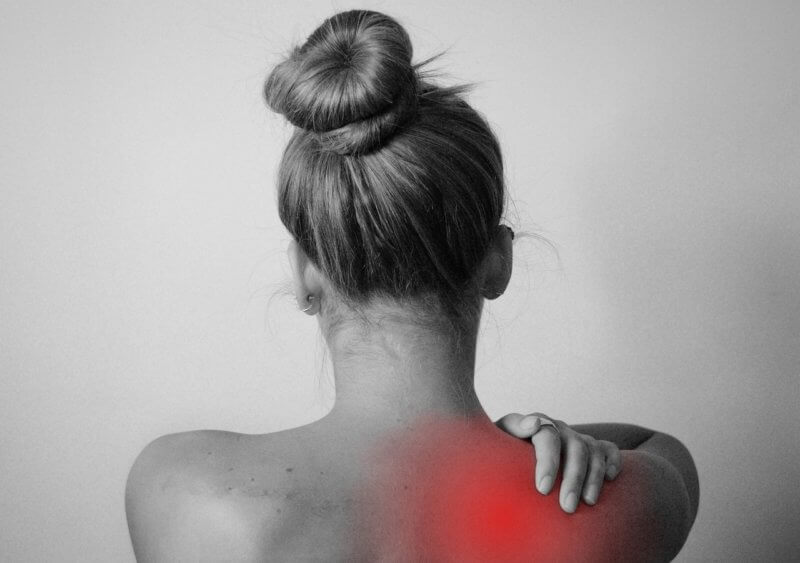A shoulder to lean on
Better posture and a few exercises go a long way
You start to notice a slight discomfort in your shoulder when you are doing simple things or when you sleep on it. We are nearly two years into the pandemic, and sitting slumped over at our computers has become far too common. You are very active on the weekends and with your seasonal activities. This sounds familiar because it is the story of most people with some level of shoulder discomfort.
A few facts:
 There are some 16 basic muscles to the shoulder complex, and when we consider the ones that attach to the collarbone, the number increases. The shoulder complex is made up of four different joints: the collarbone attaches to the sternum (breastbone), then to the scapula (shoulder blade). The humerus (upper arm bone) attaches to the scapula to make a ball-and-socket joint, and the scapula sits and moves on the ribcage.
There are some 16 basic muscles to the shoulder complex, and when we consider the ones that attach to the collarbone, the number increases. The shoulder complex is made up of four different joints: the collarbone attaches to the sternum (breastbone), then to the scapula (shoulder blade). The humerus (upper arm bone) attaches to the scapula to make a ball-and-socket joint, and the scapula sits and moves on the ribcage.
It is the most injured area of the body we see as physical therapists, and the one that usually requires the most work to rehabilitate.
There is very good radiologic evidence that most of us over the age of 50 have some wear and tear of our muscles and the joints of the shoulder. The good news is most of us will never know it and will function quite well despite these findings. That is why we treat the client and not the x-ray.
The role of posture
Our mid-back, the thoracic spine, has a normal, forward-bending curve to it. As we mature. most of us will experience more of a forward bend. This puts the scapula in a position that is less than ideal for healthy shoulder function. Try this: sit at the edge of a chair and slump forward through your entire spine. With your thumbs facing upward, raise both arms up in front of you as far as they will comfortably go. They may end up at or below ear height. Hold that arm position as you sit up straight. Where are the arms in relationship to the height of your shoulders now and how much further can you raise them? This exercise highlights the impact of the thoracic spine on the shoulder complex.
In physical therapy for treatment of clients with shoulder symptoms we will always consider both your thoracic spine and your cervical spine (neck). A routine treatment may include techniques using our hands to get the spine moving a little better. Most importantly, we give a set of exercises to encourage best posture and movement of your thoracic spine.
The rotator cuff
Often referred to as the “rotor cuff” by the layperson, this group of four muscles work to rotate and stabilize the head of the humerus on the scapula. Two of the muscles work to rotate the humerus outward, one of them rotates the humerus inward, and the fourth one on the top (the supraspinatus) works to hold the head of the humerus on the scapula. The relatively small rotator cuff muscle is the most frequently injured. Scientists are not sure why this is, but all agree that specific rotator cuff exercises can help to maintain and improve the condition of the muscles and tendons of this quartet.
Frozen shoulder
Adhesive capsulitis is the medical term for frozen shoulder, and one would be remiss not to discuss it here.
The head of the humerus sits on the scapula and is held there by the rotator cuff muscles and a capsule made up of pliable but sturdy connective tissue.
In middle-aged women and people with diabetes we see this insidious diagnosis and still have no good explanation as to why it happens.
There are three stages to this self-limiting diagnosis: freezing, frozen and thawing. A typical case could last three to 18 months, and never return.
The freezing stage comes with deep and at times throbbing and persistent pain when one moves suddenly, at night or at rest. This is combined with a progressive and frustrating loss of motion in the shoulder. The frozen stage is just what it sounds like. The shoulder is not moving; however, the pain of the previous stage is minimal to nonexistent. In the thawing stage, one has minimal pain as motion is gradually restored.
Cortisone injections in the early stages have been shown to limit the duration and dysfunction associated with frozen shoulder. As physical therapists we can help, to a point, by maintaining some level of targeted exercise while helping clients minimize their pain. However, we are most helpful as the client “thaws out,” when a more comprehensive and restorative exercise program can be offered.
Prevention and maintenance
Given the high incidence of shoulder problems, I liken upper back strengthening and targeted rotator cuff exercises to the flossing, rinsing and brushing of our teeth on a daily basis. Try these:
- Put your arms at your side, elbows bent all the way, palms facing forward, as you squeeze your shoulder blades down and back. Hold for three to five seconds and repeat five times, keeping your forearms vertical.
- Bend your elbows to 90 degrees, hug them to your ribs with forearms out in front of you (palms up). Rotate both forearms in and out, as if to say, “Got no money.” You can do as many of these as you want.
A good website for all things physical therapy.
Remember: good movement is good, for goodness’ sake.
Mike Dee, PT, SCS, is a board-certified Specialist in Sports Physical Therapy and practices at Dee Physical Therapy.
